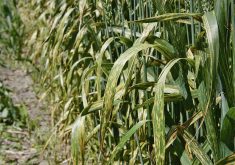Be on the lookout for insects in any grain stored over the summer or in areas around storage bins, says the Canadian Grain Commission. These insects could move easily between bins and infest the new harvest.
To protect the quality of grain currently in storage, the commission recommends the following:
- Sample the grain from the core at a depth of 30 to 50 centimetres (12 to 18 inches) from the surface. Insects are likely to be found in pockets of warm or moist grain. Sieve the samples or examine small portions carefully. Typically, stored product insects are very small beetles (less than three millimetres or one-eighth inch) that may not be moving. A magnifying glass can be helpful.
- For best results, grain temperature should be less than 15 C and have an appropriate moisture content (for example, wheat should be at or lower than 14.5 per cent moisture content).
- Summer surveys have shown that the lesser grain borer has been found across the country, particularly in Alberta, Saskatchewan, and Manitoba. The lesser grain borer is one of Canada’s most damaging pests found in stored grain.
- Insects could be grain feeders, fungal feeders, or predators of these insects. By accurately identifying insects, you can determine the appropriate control method.
- Make sure storage areas are clean and free from grain residues that can harbour or attract insects.
- If required, treat your empty storage bins with a registered contact insecticide such as malathion, pyrethrin or a diatomaceous earth-based product. Make sure you treat floor-wall joints, aeration plenums or floors and access points thoroughly. Do not use malathion in bins intended for canola storage.
Read Also

Hail research hopes to benefit potato growers
Alberta research scientist measures hail storm and heat dome affects on potato crops















